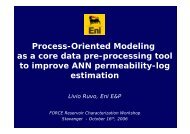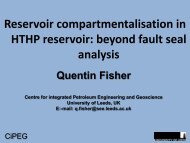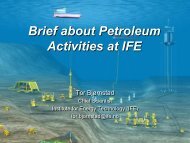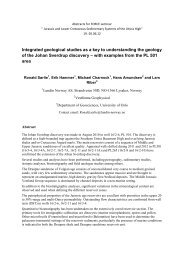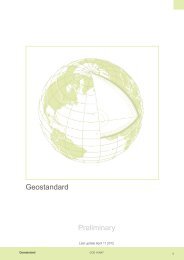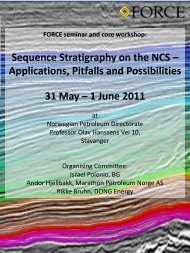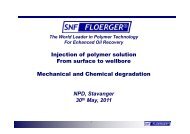Geomechanical modeling of fault reactivation related to pore ... - Force
Geomechanical modeling of fault reactivation related to pore ... - Force
Geomechanical modeling of fault reactivation related to pore ... - Force
You also want an ePaper? Increase the reach of your titles
YUMPU automatically turns print PDFs into web optimized ePapers that Google loves.
<strong>Geomechanical</strong><br />
modelling <strong>of</strong> <strong>fault</strong><br />
<strong>reactivation</strong> <strong>related</strong> <strong>to</strong><br />
<strong>pore</strong> pressure changes.<br />
Elin Skurtveit, Fabrice Cuisiat, Hans<br />
Petter Jostad, Lars Andresen<br />
FORCE HPHT workshop 10.Nov.2010
Focus <strong>of</strong> the talk<br />
• HPHT reservoirs and depletion<br />
• <strong>Geomechanical</strong> modelling <strong>related</strong> <strong>to</strong> depletion<br />
• Labora<strong>to</strong>ry testing <strong>of</strong> hydro-mechancial parameters<br />
• Case studies: Kristin and Statfjord Field
HPHT reservoirs and depletion<br />
p<br />
=( p + p s
Effect <strong>of</strong> depletion on <strong>fault</strong> in reservoirs<br />
Færseth et al. 2007<br />
• Flow and pressure<br />
barriers<br />
• Affect horizontal and<br />
vertical flow paths<br />
• Pressure<br />
compartments and<br />
large differential<br />
pressure across <strong>fault</strong>s<br />
• Stress concentration
<strong>Geomechanical</strong> modelling <strong>of</strong> pressure<br />
depletion at NGI<br />
Fault integrity<br />
Well integrity<br />
Special labora<strong>to</strong>ry testing<br />
on intact and <strong>fault</strong>ed<br />
material
<strong>Geomechanical</strong> modelling<br />
- Geometry<br />
- Stresses<br />
- Depletion<br />
- <strong>Geomechanical</strong><br />
properties<br />
- Stiffness<br />
- Strength<br />
- Permeability
How <strong>to</strong> model <strong>fault</strong> zones<br />
Geometry<br />
Complexity<br />
Fault core – type <strong>of</strong> material<br />
Damage zone<br />
Normal <strong>fault</strong>ing<br />
Drag<br />
Slumping<br />
Small <strong>fault</strong>ing parallel <strong>to</strong><br />
<strong>fault</strong> plane
Labora<strong>to</strong>ry tests<br />
Standard Triaxial testing<br />
Parameters<br />
• Strength<br />
• Deformation<br />
• Permeability<br />
• Seismic velocities<br />
• Resistivity<br />
Test conditions<br />
• Confining Pressure up <strong>to</strong> 100 MPa<br />
• Pore Pressure up <strong>to</strong> 80 MPa<br />
• Temperatures up <strong>to</strong> 160 o C
Challenges <strong>related</strong> <strong>to</strong> testing<br />
• Relevant material<br />
• Fresh and undisturbed material<br />
• Fault zone material – bad quality or missing<br />
Fault zone<br />
Shale
Ring shear test equipment<br />
Investigating basic mechanisms involved in <strong>fault</strong>ing<br />
n<br />
• Max normal s<br />
• Max shear st<br />
• Pore pressur<br />
• Flow measur<br />
ring filter segm<br />
• Test control:<br />
• Sample size:<br />
• Unlimited rota<br />
• Max rotation<br />
• Min rotation s<br />
Parameters tested:<br />
RingShearDescription.ppt<br />
Clausen & Gabrielsen,<br />
2002<br />
Shearing <strong>of</strong> pure sand, sand mixed with clay and clay layers producing clay smear<br />
Varying porosity, burial depth, clay content, number <strong>of</strong> clay layers
Ring shear tests<br />
Effect <strong>of</strong> various burial depth during shearing<br />
3 clay layers<br />
separated by<br />
sand<br />
Loading the<br />
sample <strong>to</strong><br />
required burial<br />
depth<br />
Faulting<br />
simulated by<br />
rotating lower<br />
part <strong>of</strong> ring cell<br />
Flow measurements
Observation <strong>of</strong> shear zone<br />
Clay smear<br />
• clay smear<br />
• grain rolling<br />
• cataclasis<br />
Increasing<br />
shear<br />
strength<br />
with<br />
increasing<br />
burial<br />
depth<br />
Sand shear
Field cases<br />
Kristin Field – HPHT reservoir<br />
Statfjord Field – Statfjord Late Life
Kristin Field - Halten bank<br />
<strong>Geomechanical</strong> <strong>modeling</strong> <strong>of</strong> depletion:<br />
• Reservoir deformation due increased effective stress<br />
• Total stress reduction in horizontal direction, develop<br />
shear deformation<br />
• Stress concentration around internal <strong>fault</strong>s<br />
5000 m depth<br />
90 MPa <strong>pore</strong> pressure<br />
Temperature 170 ºC<br />
Planned depletion: 60 MPa
Special labora<strong>to</strong>ry tests<br />
Material properties for calculation <strong>of</strong> compaction and deformation<br />
during depletion<br />
Defining bulk<br />
modulus<br />
Skomedal et al 2002<br />
Compressibility <strong>of</strong> the reservoir depends on the initial<br />
porosity and possibly quarts cementation
Depth (m)<br />
Fault integrity during<br />
depressurization <strong>of</strong> the Statfjord Field<br />
Poroelastic model <strong>to</strong> account for grains compressibility during depletion<br />
Use existing observations from Brent-Statfjord as verification/calibration<br />
Distance (m)<br />
10000 20000 30000 40000 50000 60000<br />
SW<br />
NE<br />
1000<br />
Brent Fault 9/4 Fault Horst<br />
2000<br />
Brent Field<br />
Statfjord Field<br />
Snorre Field<br />
3000<br />
4000<br />
4500<br />
Vertical exaggeration:3<br />
late life <strong>pore</strong> pressure depletion p ~ 300<br />
bar<br />
Sealing <strong>fault</strong> under<br />
existing pressure<br />
depletion in Brent field<br />
(300 bars)<br />
Behaviour <strong>of</strong> Horst<br />
barrier during<br />
depletion?
Fault properties<br />
• Throw from seismic sections<br />
• Empirical relationship between <strong>fault</strong><br />
throw and thickness from field analogue<br />
• Shale Gauge Ratio <strong>to</strong> define the clay<br />
content <strong>of</strong> the <strong>fault</strong><br />
• Uncertainty in thickness and damage<br />
zone investigated in parametric study<br />
(Sperrevik et al.)
Mechanical properties <strong>of</strong> <strong>fault</strong> material<br />
Controlled by clay content from<br />
SGR analysis<br />
• Clay rich <strong>fault</strong> rock<br />
assumed same<br />
properties as intact shale<br />
• Sealing <strong>fault</strong> rock with<br />
less clay assumed same<br />
properties as sands<strong>to</strong>ne<br />
or even stronger/stiffer<br />
(cataclasites)<br />
DST and CIU tests<br />
upper bound<br />
lower bound
Depth (m)<br />
Max. shear stress in Horst structure<br />
Highest shear stress for<br />
Brent group<br />
Failure possible in Brent<br />
group<br />
final<br />
initial<br />
SW<br />
Stress changes less<br />
than for Brent <strong>fault</strong><br />
1000<br />
2000<br />
Brent Field<br />
3000<br />
Distance (m)<br />
10000 20000 30000 40000 50000 60000<br />
Brent Fault 9/4 Fault Horst<br />
Statfjord Field<br />
Snorre Field<br />
NE<br />
20 MPa<br />
depletion<br />
4000<br />
4500<br />
Vertical exaggeration:3
Sources <strong>of</strong> uncertainties – parameter study<br />
- stiffness properties (reservoir, shale layers and overburden)<br />
- <strong>fault</strong> geometry (inclination, thickness, drag and juxtaposition);<br />
- pressure distribution and drainage <strong>of</strong> <strong>fault</strong> core zone.<br />
upper bound<br />
Normal <strong>fault</strong>ing<br />
Drag<br />
Slumping<br />
Small <strong>fault</strong>ing parallel <strong>to</strong><br />
<strong>fault</strong> plane<br />
lower bound
Effect <strong>of</strong> <strong>fault</strong> core thickness<br />
Highest shear stress mobilisation in sand:sand juxtaposition at the<br />
bot<strong>to</strong>m <strong>of</strong> the depleted reservoir.<br />
Maximum shear stress max in <strong>fault</strong> not significantly affected by reduced<br />
<strong>fault</strong> zone<br />
FZT = 10 m<br />
FZT = 5 m<br />
P=20 MPa<br />
Sand reservoir fm<br />
max = 11 - 12<br />
MPa<br />
max = 11 - 12<br />
MPa<br />
BASCE CASE<br />
(1)<br />
7
Effect <strong>of</strong> damage zone<br />
’damage zone’ modelled as stiffer material<br />
small positive effect<br />
Small reduction in shear stress (0.6 MPa)<br />
E = 20 MPa<br />
max = 11 - 12 MPa<br />
E = 10 MPa<br />
max = 11 - 12 MPa<br />
BASEC CASE (1)<br />
18
Results from parametric study<br />
• Maximum shear stress in <strong>fault</strong> core zone is relatively insensitive <strong>to</strong><br />
variations in geometry and stiffness parameters<br />
• positive effect <strong>of</strong> drag<br />
• largest uncertainty <strong>related</strong> <strong>to</strong> the <strong>fault</strong> peak shear strength
Conclusions<br />
• <strong>Geomechanical</strong> <strong>modeling</strong> <strong>to</strong>ols for <strong>fault</strong> integrity<br />
during depletion and methods for assessing material<br />
properties has been presented<br />
• 2D models have been used but 3D is needed for<br />
more complex geometries<br />
• Largest uncertainty <strong>related</strong> <strong>to</strong> the <strong>fault</strong> (core) peak<br />
shear strength<br />
• Further work:<br />
• Effect <strong>of</strong> shear mobilization on hydraulic communication<br />
• Determination <strong>of</strong> <strong>fault</strong> strength
Thanks!<br />
PROFUSE Project (JIP)<br />
F. Cuisiat, E. Skurtveit. (2010) An experimental investigation <strong>of</strong> the development and permeability <strong>of</strong> clay<br />
smears along <strong>fault</strong>s in uncemented sediments”. Journal <strong>of</strong> Structural Geology, In press. 2010<br />
Fabrice Cuisiat, Hans Petter Jostad; Lars Andresen; Elin Skurtveit; Eiliv Skomedal; Marc Hettema; Kellfrid Lyslo.<br />
(2010) <strong>Geomechanical</strong> integrity <strong>of</strong> sealing <strong>fault</strong>s during depressurisation <strong>of</strong> the Statfjord field”. Journal <strong>of</strong><br />
Structural Geology. In press. 2010<br />
Skomedal, E.; Jostad, H.P.; Hettema, M.H. (2002) Effect <strong>of</strong> <strong>pore</strong> pressure and stress path on rock mechanical<br />
properties for HPHT application. SPE/ISRM Rock Mechanics Conference. Irving, Texas 2002. CD-rom. Paper<br />
SPE 78152. 10p.



